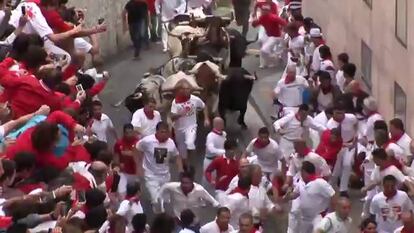What the heck am I doing here? A guide to running with the bulls in Pamplona
A personal account of the inexplicable madness that fuels the San Fermín festival every July
The idea of jumping a fence to run in front of six fighting bulls that could kill you at any moment cannot be explained with logic; instead it has to be filed under that heading that encompasses acts of surrealism, recklessness bordering on the suicidal, and the irresistible, adrenaline-fueled need to put yourself to the test, to put life to the test, to put death to the test. I suspect this is what psychiatrists tell their patients as they lie on the couch. Certainly, they are the arguments that the runners use when they talk about their excitement and fear.
It’s 8am, and the bells of San Cernin church are ringing. Invisible needles prick at the feet and the souls of each and every runner in today’s encierro. The first firecracker goes off: the herd is released. Why are you here? Your mouth is dry; you have this urge to say “hi” to everyone you see, whether you know them or not; and you can’t stop yourself obsessively tying and untying your shoelaces. You’re trapped on the wheel of madness, part of an invisible brotherhood with the other runners. Your palms are sweaty and the July sun is peeking through the rooftops of Pamplona, as though to remind you that you could be sitting at a street café in Plaza del Castillo or on Mañueta street, breakfasting on chocolate con churros.
One gored in first run of 2014
There was a big turnout, tension and excitement at the first running of the bulls of this year’s San Fermin festival in Pamplona on Monday morning.
One person was gored and three others were taken to hospital with other injuries during the encierro, which featured just five, rather than the regular six, bulls from the Torrestrella ranch after one was injured as it was herded to the starting enclosure the night before.
Torrestrella is the ranch responsible for the second-most gorings in sanfermines history, and the bulls took no time in living up to their reputation. The goring was one of the earliest ever recorded: just a few seconds after the start, one bull that had gone off at full speed veered towards the right-hand sidewalk and gored a runner who had been unable to make it to the barrier in time.
The other injuries took place in Mercaderes street in a fast, frenetic and lively encierro lasting two minutes and 25 seconds.
But instead you are here.
If you have chosen Cuesta de Santo Domingo at the beginning of the course as your starting point, you’ll need good eyes, and you’ll need to train them on where you think you are going to start running. Whatever you do, do not wait for the bulls to be breathing down your neck before you start moving. Not even for them to be 10 or 12 meters away. Take your reference point to be something that looks like it might be 20 to 25 meters distant, place yourself in the middle of the street, and run, run, run. And as you run, keep looking back – quickly, just tenths of a second each time – to ensure the group does not gain on you too quickly and either a) passes you by without you even realizing, or b) catches you and affords you no way out. But don’t forget to also look in front of you, to avoid tripping over other runners. Overcrowding is as dangerous as the bulls. So, in short, try to have four eyes instead of two. Sounds complicated? Well, why did you come in the first place?
As they hurtle up Santo Domingo and veer towards the first runners stuck to the side barriers, the fighting bulls are in their splendor – not to mention their moment of maximum panic. Keep in mind that only yesterday they were treading the sweet, soothing grass of the meadow and now they are on hard, unfamiliar cobblestones. Animals weighing over 600 kilos cover this 280-meter, six percent slope like the devil were on their tails, and in 20 seconds or so they are already in Plaza del Ayuntamiento. This is where the first American citizen to be gored to death, 22-year-old Matthew Peter Tassio, was hit on July 13, 1995. Tassio, who had arrived in Pamplona just two days earlier, was never told one of the golden rules of the encierro: if you fall, stay down, kiss the ground, protect your head with your arms and hands, and pray to San Fermín if you are the praying kind – and if you’re not, pray anyway. Tassio fell and tried to get up again. He didn’t have time to see the horns coming straight at him. There have been 15 deaths at the sanfermines since 1922, the year considered the beginning of the modern era of the encierros. Since then, the route has invariably been the same: 848.6 meters starting in the corrals of San Domingo and ending in the city’s bullring.
Between the final stretch of the Cuesta de Santo Domingo and the first meters of Mercaderes street, runners cover around 80 meters diagonally. This is the widest section of the course. After a slight curve left, the herd takes Mercaderes and aims for one of the most spectacular, not to mention dangerous, spots of all: the curve that separates Mercaderes from Estafeta street. It is so sharp, it’s practically a right angle.
It is here – where photographers from all over the world place their cameras, including the extraordinary Jim Hollander, the American reporter who spent 30 years covering the sanfermines for Reuters and other media outlets, and probably the foreign journalist most familiar with the curve – that the bulls skid and slam against the fences. So here is a warning to first-timers: make sure you don’t take the curve on the outside, unless you want to become a human sandwich. Always take it on the inside, or in the middle of the street at the most.
If you fall, stay down, kiss the ground, protect your head with your arms and hands, and pray to San Fermín if you are the praying kind
Estafeta stretches in a straight line for 305 meters with a slight slope. Every one of the 2,000 to 3,000 runners (depending on the day, although overcrowding is always a problem) has his favorite spot, but a particularly fascinating one is located 20 to 30 meters from the tight bend where the bulls slip and slide – though a lot less so since they started treating the ground with non-slip products in 1998. This is a magical spot from which to begin your run.
Your initial fear, which will be followed by the stress of elbowing your way through the running crowd, will not prevent your senses from being fully aware of the sound of 56 hooves (six bulls and eight steer who guide them along) hitting the stones, the roar, the panicked screams of the people looking down from the balconies, and above all the smell of bull. The unmistakeable, bitter, pungent smell of bull.
The early why-am-I-here musings have given way to a ferocious immediacy in which you think of nothing; you just look, shove, run, jump, avoid, scream, fall, get up, and if it comes down to it, bow out quickly so as not to get in the way of the people coming up behind you.
Estafeta ends in a sharp left curve. This stretch is always packed with people and the patas density is high. Patas, literally legs, is the term given to people not running but just standing there, either to take pictures or videos, or to touch the bulls as they go by – in other words, the two most forbidden things at the sanfermines. We are only talking about 60 meters, but it is a very dangerous antechamber to the bullring. Idiots with an adventurous vein and fools only wanting to capture the moment on your cellphones and upload it to Facebook, YouTube or Twitter: please abstain.
Slowly, the saliva returns to your mouth. You sit down on the ground. You think. You remember. And you never forget. Never
This is where the most accidents have occurred. There is no way out should a hapless runner come into close and undesired contact with one of the beasts. There have been over 20 human pile-ups throughout the years, with an especially tragic one on July 8, 1977, when 17-year-old José Joaquín Esparza, a native of Pamplona, either suffocated to death or was killed when a bull stepped on him (the exact cause of his death was never very clear). This is also the place where Julen Madina, a Basque runner with a lot of experience, was dramatically gored up to six times in 2004.
The encierro finally reaches the bullring. If you have made it this far, fan out left or right as soon as you step on to the sand. Never, ever keep running toward the middle.
And so your own particular encierro is now part of history. Slowly, the saliva returns to your mouth. You sit down on the ground. You think. You remember. And you never forget. Never.
Don’t ask why, it will be useless. It doesn’t matter whether you also like surfing with white sharks, parachuting out of planes, spending your afternoons among gorillas in Rwanda, or following the trail of the Bengali tiger. There is nothing like the bulls running down the streets of Pamplona. And you running in front of them.
We will keep on reading Freud.
Tu suscripción se está usando en otro dispositivo
¿Quieres añadir otro usuario a tu suscripción?
Si continúas leyendo en este dispositivo, no se podrá leer en el otro.
FlechaTu suscripción se está usando en otro dispositivo y solo puedes acceder a EL PAÍS desde un dispositivo a la vez.
Si quieres compartir tu cuenta, cambia tu suscripción a la modalidad Premium, así podrás añadir otro usuario. Cada uno accederá con su propia cuenta de email, lo que os permitirá personalizar vuestra experiencia en EL PAÍS.
¿Tienes una suscripción de empresa? Accede aquí para contratar más cuentas.
En el caso de no saber quién está usando tu cuenta, te recomendamos cambiar tu contraseña aquí.
Si decides continuar compartiendo tu cuenta, este mensaje se mostrará en tu dispositivo y en el de la otra persona que está usando tu cuenta de forma indefinida, afectando a tu experiencia de lectura. Puedes consultar aquí los términos y condiciones de la suscripción digital.
Archived In
Últimas noticias
Reinhard Genzel, Nobel laureate in physics: ‘One-minute videos will never give you the truth’
Pinochet’s victims grapple with José Antonio Kast’s rise in Chile
From digital curfews to blocking apps: How technology experts protect their children online
Why the price of coffee has skyrocketed: from Brazilian plantations to specialty coffee houses
Most viewed
- Pablo Escobar’s hippos: A serious environmental problem, 40 years on
- Why we lost the habit of sleeping in two segments and how that changed our sense of time
- Trump’s obsession with putting his name on everything is unprecedented in the United States
- Charles Dubouloz, mountaineering star, retires at 36 with a farewell tour inspired by Walter Bonatti
- The Florida Keys tourist paradise is besieged by immigration agents: ‘We’ve never seen anything like this’










































